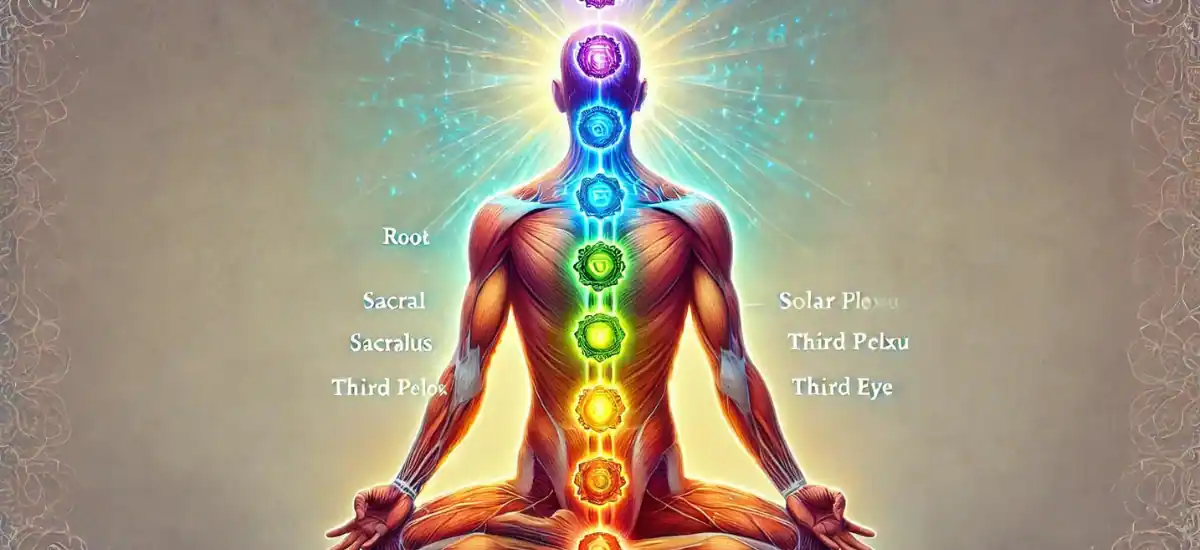The concept of chakras, energy centers recognized across various spiritual traditions, has played a pivotal role in holistic health practices. These centers, or “wheels of light,” as described in ancient Indian traditions, regulate energy flow throughout the body, balancing physical and spiritual health.
Interestingly, modern science has found correlations between chakra points and the endocrine system, underscoring the interconnection between ancient wisdom and contemporary health practices.
This guide delves into the seven main chakras, exploring their locations, associations, and roles in maintaining overall wellness. By understanding these chakra points, individuals can achieve balanced energy flow, promoting both physical and spiritual well-being.
Understanding the Chakra System
Chakras, derived from the Sanskrit word meaning “wheel,” are energy centers that regulate the flow of energy throughout the body. These spiritual and physical regulators play a crucial role in maintaining balance and overall wellness.
Ancient Indian Perspective
- Spinning Wheels of Light: In ancient Indian traditions, chakras are seen as spinning wheels of light, governing energy flow. These wheels rotate, pulling energy from the universe and distributing it throughout the body, maintaining harmony between physical, emotional, and spiritual aspects.
- Energy Flow: Chakras facilitate the movement of prana (life force) through the body’s energy channels, or nadis, ensuring a balanced flow that supports holistic health.
Function as Regulators
- Physical Regulation: Each chakra corresponds to a specific region of the body, influencing physical functions. For instance, the Solar Plexus Chakra governs the digestive system, while the Heart Chakra affects cardiovascular health.
- Spiritual Regulation: Chakras also regulate spiritual energy, fostering intuition, insight, and connection to higher states of consciousness. The Third Eye Chakra, for example, enhances intuition and insight, while the Crown Chakra promotes spiritual connection.
Holistic Health
- Balancing the Chakras: Ensuring each chakra is balanced and functioning optimally promotes holistic health, aligning physical, emotional, and spiritual well-being.
- Blockages and Imbalances: When chakras are blocked or imbalanced, it can lead to physical ailments, emotional disturbances, or spiritual disconnect. Recognizing and addressing these blockages is crucial for maintaining overall wellness.
Chakra Locations and Associations
Each of the seven main chakras has a specific location in the body and governs various aspects of physical and spiritual health. Here’s a detailed look at each chakra’s position and its associations:
1. Root Chakra (Muladhara)
- Location: The Root Chakra is located at the base of the spine, near the tailbone.
- Associations: This chakra governs survival instincts, physical security, and grounding. It connects to the reproductive organs, influencing foundational instincts such as stability, safety, and basic needs.
- Role: A balanced Root Chakra fosters a sense of security and grounding, promoting overall physical and emotional well-being.
2. Sacral Chakra (Svadhishthana)
- Location: The Sacral Chakra is situated in the lower abdomen, around the sacrum.
- Associations: This chakra is connected to emotional and creative expression, as well as sexual energy. It influences the adrenal glands, supporting emotional balance, sexual health, and creative flow.
- Role: A balanced Sacral Chakra enhances emotional stability, healthy relationships, and creative potential.
3. Solar Plexus Chakra (Manipura)
- Location: The Solar Plexus Chakra is found in the upper abdomen, around the solar plexus region.
- Associations: This chakra governs personal power, self-confidence, and transformation, aligning with the pancreas to regulate digestion and metabolism.
- Role: A balanced Solar Plexus Chakra boosts self-esteem, motivation, and personal growth, supporting overall health.
4. Heart Chakra (Anahata)
- Location: The Heart Chakra is located in the center of the chest, near the heart.
- Associations: This chakra is tied to love, compassion, and connection, influencing the thymus gland to support immune function.
- Role: A balanced Heart Chakra fosters harmonious relationships, emotional healing, and cardiovascular health.
5. Throat Chakra (Vishuddha)
- Location: The Throat Chakra is situated in the throat area.
- Associations: This chakra governs communication, self-expression, and authenticity, aligning with the thyroid gland to regulate metabolism and growth.
- Role: A balanced Throat Chakra enhances clear communication, self-expression, and overall well-being.
6. Third Eye Chakra (Ajna)
- Location: The Third Eye Chakra is located in the forehead, between the eyebrows.
- Associations: This chakra is a center for intuition, insight, and mental clarity, influencing the pineal gland to regulate sleep and wakefulness.
- Role: A balanced Third Eye Chakra sharpens perception, enhances mental clarity, and supports intuitive decision-making.
7. Crown Chakra (Sahasrara)
- Location: The Crown Chakra is situated at the top of the head.
- Associations: This chakra is linked to spiritual connection, enlightenment, and higher states of consciousness, influencing the pituitary gland to regulate other endocrine glands.
- Role: A balanced Crown Chakra fosters spiritual growth, holistic well-being, and mental health.
Visual Aid Suggestion:
A diagram illustrating the locations of these chakras on the body can serve as a useful reference, helping readers understand their physical and energetic associations.
This exploration of each chakra’s location and associations provides a foundation for understanding their role in holistic health, setting the stage for further discussion on their connection to the endocrine system.
Chakras and the Endocrine System
The chakra system’s alignment with the body’s endocrine system highlights its dual role as a spiritual and physical regulator. Here’s how each chakra corresponds to specific endocrine glands:
1. Root Chakra
- Gland: Gonads (testes/ovaries)
- Function: The Root Chakra influences foundational instincts, such as survival, stability, and basic needs. Its connection to the gonads affects reproductive health, emphasizing the chakra’s role in physical well-being.
2. Sacral Chakra
- Gland: Adrenal glands
- Function: This chakra governs emotional and sexual functions, aligning with the adrenal glands, which produce hormones like adrenaline and cortisol. These hormones regulate stress responses, energy levels, and emotional balance.
3. Solar Plexus Chakra
- Gland: Pancreas
- Function: The Solar Plexus Chakra influences digestive functions, aligning with the pancreas to regulate metabolism and blood sugar levels. A balanced chakra supports healthy digestion, metabolism, and overall energy levels.
4. Heart Chakra
- Gland: Thymus
- Function: This chakra affects love, compassion, and connection, connecting with the thymus gland to support immune function. A balanced Heart Chakra fosters harmonious relationships and healthy immune responses.
5. Throat Chakra
- Gland: Thyroid
- Function: The Throat Chakra governs communication, self-expression, and authenticity, aligning with the thyroid gland to regulate metabolism, growth, and development. A balanced chakra enhances communication and overall well-being.
6. Third Eye Chakra
- Gland: Pineal gland
- Function: This chakra influences intuition, insight, and mental clarity, connecting to the pineal gland, which regulates sleep-wake cycles through melatonin production. A balanced Third Eye Chakra supports mental clarity and healthy sleep patterns.
7. Crown Chakra
- Gland: Pituitary gland
- Function: The Crown Chakra connects to spiritual connection, enlightenment, and higher consciousness, aligning with the pituitary gland, which regulates other endocrine glands. This balance fosters holistic well-being, connecting spiritual and physical health.
This alignment between chakras and the endocrine system highlights their role in holistic wellness, balancing physical functions and spiritual energy. The next section delves deeper into how balanced chakras contribute to both physical and spiritual health, offering insights into identifying and correcting imbalances.
Physical and Spiritual Health
Balanced chakras contribute to holistic wellness, integrating both physical health and spiritual well-being. Here’s how balanced chakras support overall well-being, along with methods to identify and correct imbalances:
Physical Health
- Bodily Functions: Each chakra corresponds to specific organs and systems, influencing functions such as digestion, immunity, and metabolism. For instance, the Solar Plexus Chakra regulates digestion, while the Heart Chakra affects cardiovascular health.
- Endocrine System: The chakras’ alignment with endocrine glands highlights their role in regulating hormones, supporting growth, development, and stress responses. A balanced chakra system ensures proper endocrine function, maintaining physical health.
Spiritual Health
- Energy Flow: Balanced chakras allow energy to flow freely throughout the body, preventing blockages that can lead to spiritual disconnect. This harmonious energy flow fosters spiritual growth, connection, and enlightenment.
- Emotional Balance: Chakras also influence emotions, with each chakra governing different emotional states. For example, the Sacral Chakra governs creativity and emotional expression, while the Heart Chakra regulates love and compassion.
Identifying Imbalances
- Physical Symptoms: Imbalanced chakras can manifest as physical ailments, such as digestive issues, hormonal imbalances, or respiratory problems, depending on the affected chakra.
- Emotional and Spiritual Signs: Blocked chakras can also cause emotional disturbances, such as anxiety, lack of confidence, or spiritual disconnect. Recognizing these signs can help identify and address imbalances.
Correcting Imbalances
- Healing Techniques: Various practices, such as meditation, yoga, and energy healing, can help balance chakras, restoring harmony to the body’s energy flow.
- Lifestyle Adjustments: Adjustments to diet, exercise, and daily routines can also support chakra health, ensuring balanced energy flow and holistic wellness.
This exploration of balanced chakras highlights their importance for both physical and spiritual health, setting the stage for practical applications that integrate chakra healing into daily life.
Practical Applications
Maintaining balanced chakras is essential for holistic well-being. Here are practical ways to integrate chakra healing into daily life through meditation, yoga, and other holistic practices:
Meditation
- Guided Meditations: Practice guided meditations that focus on specific chakras, incorporating visualizations, mantras, or breathing exercises. For instance, visualizing a green light radiating from the Heart Chakra while repeating “I give and receive love freely” can restore balance to this energy center.
- Chakra-focused Meditations: Set aside time daily to meditate on each chakra, starting from the Root Chakra and working upward. This sequential approach ensures all chakras are addressed, promoting overall balance.
Yoga
- Chakra-aligned Poses: Incorporate yoga poses that stimulate specific chakras, enhancing energy flow. For example, Tree Pose and Mountain Pose promote grounding for the Root Chakra, while Camel Pose opens the Heart Chakra, fostering love and compassion.
- Holistic Practice: Regular yoga practice can support chakra health, balancing energy flow throughout the body and enhancing overall wellness.
Other Healing Techniques
- Reiki: Energy healing practices like Reiki can help cleanse and balance chakras, removing blockages and restoring harmonious energy flow. This practice involves directing healing energy into each chakra, promoting physical and spiritual health.
- Sound Healing: Sound healing uses frequencies and vibrations to resonate with specific chakras, helping balance their energies. Instruments like singing bowls or tuning forks can target each chakra, promoting alignment and harmony.
Lifestyle Adjustments
- Diet: Incorporate foods that align with each chakra’s energy. For instance, root vegetables like carrots and potatoes can ground the Root Chakra, while green foods like spinach and broccoli can support the Heart Chakra.
- Mindful Living: Adopt daily habits that promote balance, such as regular exercise, adequate sleep, and positive thinking, ensuring holistic well-being.
These practical applications provide tools to integrate chakra healing into daily life, supporting both physical and spiritual wellness.
Conclusion
The chakra system bridges ancient wisdom and modern science, connecting energy flow to both physical and spiritual health. Understanding and balancing each chakra fosters holistic well-being, integrating physical functions with emotional and spiritual harmony.
By integrating practices like meditation, yoga, and energy healing, individuals can maintain balanced chakras, promoting harmonious energy flow throughout the body. This balance supports physical health, emotional stability, and spiritual connection, creating a path to holistic wellness.







